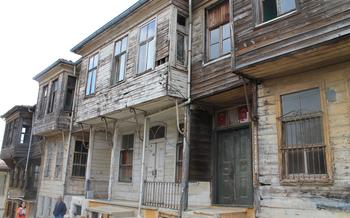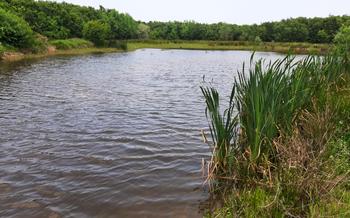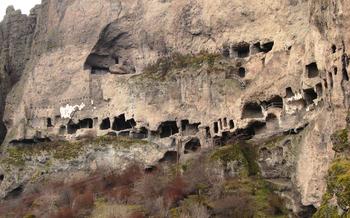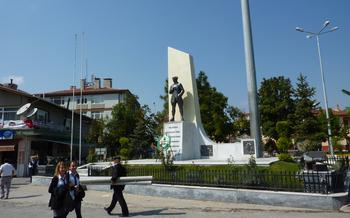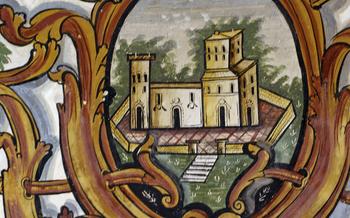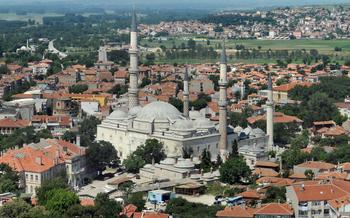
Dupnisa Cave
- Historical Significance
- Geological Formation
- Archaeological Discoveries
- Cave Paintings and Engravings
- Natural Wonders
- Guided Tours
- Visitor Facilities
- Best time to visit
- Getting There
- Admission Fees and Timings
- What to Bring
- Nearby Attractions
- Photography Tips
- Insider Tip: Unveil the Secret Altar
Historical Significance
The Dupnisa Cave holds immense historical significance, dating back to ancient times. It is believed to have been inhabited by Thracian tribes, who held the cave in high regard as a sacred site. Evidence suggests that the cave served as a place of worship and ritualistic practices for these ancient civilizations. The cave's unique features, such as its natural acoustics and intricate rock formations, may have contributed to its reputation as a spiritual sanctuary. Archaeological discoveries within the cave have shed light on the religious beliefs and practices of the Thracians, providing valuable insights into their cultural and spiritual heritage. The Dupnisa Cave continues to captivate visitors with its historical aura and serves as a testament to the rich cultural tapestry of the region.
Geological Formation
The Dupnisa Cave is a remarkable geological wonder, shaped by millions of years of natural processes. The cave's intricate structure and unique features are a testament to the Earth's powerful forces.
The formation of the Dupnisa Cave began with the uplift of the region, which exposed the underlying limestone layers. Over time, rainwater seeped into the fissures and cracks in the limestone, slowly dissolving the rock and creating underground cavities. The water's erosive action, combined with the collapse of unstable rock formations, led to the development of the cave's chambers, tunnels, and impressive stalactites and stalagmites.
The geological composition of the Dupnisa Cave is predominantly limestone, a sedimentary rock formed from the accumulation of calcium carbonate. The cave's walls and formations display various shades of beige, brown, and gray, reflecting the different mineral compositions and depositional environments.
The Dupnisa Cave's geological significance extends beyond its aesthetic beauty. The cave provides valuable insights into the region's geological history, including the formation of karst landscapes, the movement of groundwater, and the impact of tectonic activity. Ongoing geological studies and conservation efforts aim to preserve the cave's unique features and contribute to our understanding of Earth's geological processes.
Archaeological Discoveries
The Dupnisa Cave has yielded a treasure trove of archaeological discoveries that have shed light on ancient cultures and civilizations. Excavations within the cave have unearthed a wealth of artifacts, including tools, weapons, pottery, and jewelry, providing valuable insights into the daily lives and practices of the people who inhabited the region. Among the most significant finds are intricately carved stone tools, suggesting advanced craftsmanship and artistic expression. The presence of ceramic vessels and pottery fragments indicates the development of agricultural practices and the storage of food supplies. Jewelry items, such as beads and pendants, offer glimpses into personal adornment and cultural traditions. These discoveries have contributed significantly to our understanding of the cultural evolution and social dynamics of the ancient populations that called the Dupnisa Cave their home. Ongoing archaeological research continues to uncover new artifacts and information, further enriching our knowledge of this fascinating historical site.
Cave Paintings and Engravings
The Dupnisa Cave is renowned for its impressive collection of cave paintings and engravings, which offer a glimpse into the artistic expressions and beliefs of ancient civilizations. These artworks, created using techniques such as carving, scraping, and painting, showcase a variety of subjects, including animals, humans, hunting scenes, and geometric patterns. The cave paintings exhibit a mastery of line and form, demonstrating the artistic prowess of our ancestors.
The most notable paintings include a depiction of a large deer with intricate antlers, a group of human figures engaged in a ritual dance, and a series of abstract symbols that may hold religious or cultural significance. These artworks provide valuable insights into the daily lives, beliefs, and traditions of the ancient Thracian tribes who inhabited the region.
Archaeologists and art historians have extensively studied the cave paintings and engravings, attempting to decipher their meanings and symbolism. Some believe that the paintings served as a form of communication, storytelling, or religious expression. Others suggest that they may have been used for educational or ceremonial purposes, or as a way to mark important events or achievements.
Efforts are underway to preserve and study these ancient artworks, ensuring their legacy for future generations. Conservation measures include climate control, lighting management, and restricted access to prevent damage or deterioration. The cave paintings and engravings of the Dupnisa Cave stand as a testament to the creativity and cultural heritage of our ancestors, offering a unique window into the past.
Natural Wonders
The Dupnisa Cave is a treasure trove of natural wonders, captivating visitors with its stunning array of stalactites, stalagmites, and otherworldly rock formations. As you venture deeper into the cave, you'll be amazed by the intricate patterns and textures created by centuries of water erosion. The cave's walls are adorned with delicate flowstones, resembling frozen waterfalls, and towering columns rise from the ground like ancient sentinels. The interplay of light and shadow within the cave creates a mesmerizing spectacle, enhancing the beauty of these natural sculptures.
Beyond its aesthetic appeal, the Dupnisa Cave holds ecological significance as a habitat for a diverse range of wildlife. Bats, the cave's most prominent inhabitants, play a crucial role in the local ecosystem by controlling insect populations and pollinating nearby plants. Other creatures, such as spiders, beetles, and millipedes, thrive in the cave's unique microclimate, contributing to the cave's biodiversity. The cave's intricate network of tunnels and chambers provides shelter and nesting sites for these creatures, creating a vibrant underground community.
Guided Tours
To enhance your caving experience, guided tours are available to provide insights and ensure a safe and informative journey through the Dupnisa Cave. Standard tours offer a comprehensive overview of the cave's history, geology, and significant discoveries. Specialized tours cater to specific interests, such as archaeology, geology, or photography. For a more personalized experience, private tours allow you to tailor your visit according to your interests and pace.
Experienced guides lead these tours, sharing their knowledge and expertise about the cave's unique features. They will guide you through the cave's chambers, pointing out important geological formations, archaeological discoveries, and cave paintings. By participating in a guided tour, you'll gain a deeper understanding of the cave's significance and its role in ancient civilizations.
Several tour operators and companies offer guided tours of the Dupnisa Cave. It is advisable to book your tour in advance, especially during peak tourist season, to secure your spot and avoid disappointment.
Visitor Facilities
The Dupnisa Cave is well-equipped to accommodate visitors with a range of facilities and amenities. A modern visitor center serves as the starting point for exploring the cave, providing essential information, maps, and guided tours. The center also houses a small museum showcasing artifacts discovered within the cave, offering a glimpse into its rich history and cultural significance.
Parking areas are conveniently located near the visitor center, allowing visitors to park their vehicles safely. Restrooms are available on-site, ensuring the comfort and convenience of visitors during their exploration.
Accessibility is a key priority at the Dupnisa Cave, with designated pathways and ramps ensuring that visitors with disabilities and special needs can fully enjoy the cave's wonders. Guided tours are tailored to accommodate visitors with different abilities, ensuring an inclusive and enriching experience for all.
Additional facilities at the cave include a gift shop where visitors can purchase souvenirs and mementos to remember their visit. A small café offers refreshments and snacks for those seeking a quick bite or a refreshing break during their exploration.
Best time to visit
The best time to visit the Dupnisa Cave is during the spring or autumn months (April-May and September-October) when the weather is mild and pleasant. During these seasons, you can comfortably explore the cave without facing extreme heat or cold. Additionally, the spring months bring a vibrant display of wildflowers, while the autumn months offer stunning foliage views in the surrounding area.
Summer months (June-August) can be hot and crowded, especially during peak tourist season. While the cave's temperature remains relatively cool, the crowds can make it difficult to fully appreciate the cave's beauty and tranquility.
Winter months (November-March) can be cold and snowy, making it challenging to access the cave. However, if you're lucky enough to catch a clear winter day, the snow-covered landscape creates a magical and picturesque backdrop for your cave exploration.
To avoid disappointment, it's advisable to check the weather forecast before your visit and plan accordingly. If you're visiting during peak season, consider booking your tickets in advance to secure your spot.
Getting There
To reach the Dupnisa Cave, you have several options depending on your starting point. From Istanbul, the largest city in Turkey, you can take a comfortable bus ride that will take approximately 4 hours. Alternatively, you can opt for a scenic train journey, which takes about 5 hours and offers breathtaking views of the Turkish countryside. If you prefer driving, the cave is easily accessible by car from Istanbul, with a well-maintained highway connecting the two destinations. The drive takes around 3 hours and 30 minutes.
Once you arrive in Edirne, the city closest to the cave, you can take a short taxi ride or rent a car to cover the remaining distance. The cave is situated just a few kilometers outside the city center, and the drive takes approximately 15 minutes. The roads leading to the cave are generally in good condition, making it a convenient and enjoyable journey.
Admission Fees and Timings
Visiting the Dupnisa Cave is a budget-friendly experience with affordable admission fees. Regular tickets typically range from 20 to 50 Turkish Lira, depending on the season and any special exhibitions or events. Students, seniors, and groups may be eligible for discounted rates, so be sure to inquire when purchasing tickets.
The cave is open to the public daily from 8:00 AM to 6:00 PM, providing ample time for exploration and admiration of its natural wonders. However, it is advisable to arrive early, especially during peak tourist season, to avoid queues and crowds. To ensure a smooth and hassle-free visit, consider booking tickets online in advance, particularly if you have a specific time or date in mind.
What to Bring
When embarking on an adventure into the Dupnisa Cave, it is crucial to come prepared with the appropriate gear and essentials. First and foremost, prioritize comfortable clothing that allows for freedom of movement. Sturdy footwear with good traction is paramount for navigating the uneven terrain and slippery surfaces within the cave. Additionally, layers are recommended to adjust to changing temperatures.
For those eager to capture the cave's mesmerizing beauty, a camera is a must-have. However, it is essential to note the challenges of cave photography, such as low light conditions and reflections. A sturdy tripod and a flashlight or headlamp can significantly enhance your photography experience.
Remember to carry a small backpack or bag to store your belongings conveniently. A water bottle is essential for staying hydrated, especially during extended cave exploration. Snacks can provide a quick energy boost to keep you going throughout your adventure. Finally, a first-aid kit is always a wise precaution in case of minor injuries or emergencies.
Nearby Attractions
Beyond the enchanting realm of the Dupnisa Cave, the surrounding region beckons with a tapestry of captivating experiences. History buffs can delve into the ancient world at the nearby Edirne Museum, showcasing Thracian artifacts and offering glimpses into the region's rich past. Nature enthusiasts will find solace in the serene embrace of Kırkpınar National Park, renowned for its picturesque landscapes, lush forests, and diverse wildlife. For a taste of local culture, visitors can explore the vibrant city of Edirne, savoring its delicious cuisine, shopping for traditional handicrafts, and immersing themselves in the warmth of Turkish hospitality. Whether seeking historical enlightenment, natural wonders, or cultural immersion, the vicinity of the Dupnisa Cave offers a wealth of experiences to enrich any traveler's journey.
Photography Tips
Capturing the beauty of the Dupnisa Cave through photography is a rewarding experience, but it requires some technical skill and knowledge. The cave's low light conditions and reflective surfaces can be challenging, but with the right techniques, you can create stunning images.
-
Camera Settings: Use a wide-angle lens to capture the vastness of the cave chambers. Set your camera to a low ISO to minimize noise, and use a tripod to stabilize your shots.
-
Lighting: Experiment with different lighting techniques to enhance the cave's features. Use a flashlight or headlamp to highlight specific formations, or use natural light from the cave's entrance to create dramatic silhouettes.
-
Composition: Pay attention to composition to create visually appealing images. Look for leading lines, patterns, and symmetry within the cave. Experiment with different angles and perspectives to find unique compositions.
-
Inspiration: Study the work of renowned cave photographers to gain inspiration and learn from their techniques. Look for examples of cave photography that showcase the unique characteristics of the Dupnisa Cave.
Insider Tip: Unveil the Secret Altar
For those seeking a truly unforgettable experience, venture deeper into the cave's recesses to discover a hidden gem—the Secret Altar. Concealed behind a narrow passageway, this sacred site was once used by ancient Thracian tribes for religious rituals and ceremonies. The altar, adorned with intricate carvings and symbols, exudes an aura of mystery and spirituality. To reach this hidden chamber, follow the main path until you encounter a small opening on the left. Crouch low and crawl through the narrow passage, and you will emerge into a secluded chamber where the Secret Altar awaits. This hidden treasure offers a glimpse into the spiritual and religious practices of ancient civilizations, making it a must-see for history buffs and adventurers alike.
